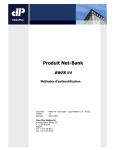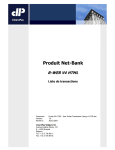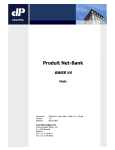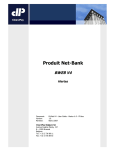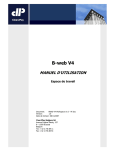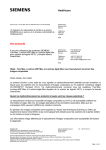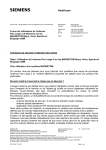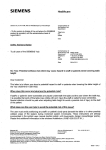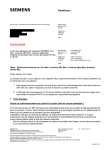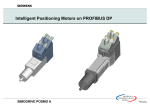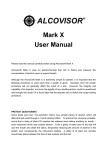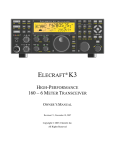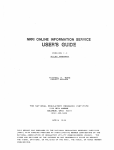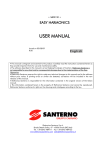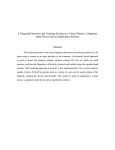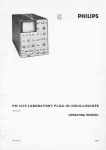Download ISO 13849-1 - Erlätuerungen zur Anwendung
Transcript
Industry Siemens AG, I IA CD, P.O. box 48 48, D-90026 Nuremberg Name Department Telephone Fax Mobile E-mail Your letter Our reference Date Patrick Gehlen Bernard Mysliwiec I IA +49 911 895-5900 +49 911 895-5907 [email protected] PG-BM, Positionswitch_PLd_Cat3_SIL2, Info 1 April 22, 2009 _ Achievement of Performance Level PL d with Category 3 according to ISO 13849-1 or SIL 2 according to IEC 62061 with application of only one SIRIUS Position switch with or without solenoid interlocking (type 2) or only one SIRIUS Hinge switch General If an electromechanical position switch fulfils the requirements of ISO 13849-1, Annex K, then, due to EN ISO 13849-2, it is about a so called „well-tried component“. To achieve Performance Level PL d with Category 3 according to ISO 13849-1 under use of only one position switch or only one hinge switch as well-tried component, „fault exclusions“ shall be defined for the „electrical portion“ as well as for the „mechanical portion“ of the position switch (and where required also for the approach mechanism). The international standard ISO 13849-1 allows fault exclusions (see section 7.2): in this case the constructor of a machine has to indicate how these fault exclusions are justified (by description of conditions for the well-tried methods etc.). By application of well-tried safety principles, fault exclusions for mechanical systems are legitimated, too: Thus by appropriate fastening (constructive measure) of the position switch and the separate actuator a fracture of the separate actuator can be excluded (see page 5 of this letter). With means of an additional 2-channel electrical version (with positive opening contacts) of the position switch it is possible to accomplish Performance Level PL d with Category 3 according to ISO 13849-1. Application and fastening shall always be carried out considering the manufacturer instructions under the declared specifications and they must not change in the period of operation. Since the machine manufacturer has to supply evidence for fault exclusion, the component manufacturer can not issue a final statement about the measures implemented. The constructional determined fastening of the position switch or the hinge switch to a rotary axis lets a fault exclusion for Performance Level PL e with Category 4 according to ISO 13849-1 appear rather questionably. However, for an application with Performance Level PL d with Category 3 according to ISO 13849-1 a fault exclusion is conceivable (likewise similar interpretation at the position switches with or without solenoid interlocking, e.g. for machine tools). Siemens AG Industry Sector Management: Heinrich Hiesinger Postal address: Siemens AG I IA CD P.O. box 48 48 D-90026 Nuremberg Office address: Gleiwitzer Str. 555 Moorenbrunn D-90475 Nuremberg Tel.: +49 911 895 5900 Fax: +49 911 895 5907 Siemens Aktiengesellschaft: CEO of the Supervisory Board: Gerhard Cromme Executive Board: Peter Löscher, CEO; Wolfgang Dehen, Heinrich Hiesinger, Joe Kaeser, Barbara Kux, Hermann Requardt, Siegfried Russwurm, Peter Y. Solmssen Corporate domiciles: Berlin and Munich; register courts: Berlin Charlottenburg, HRB 12300, Munich, HRB 6684 WEEE Reg. No. DE 23691322 ISO13849_IEC62061_SIRIUS_3SE_PLd-KAT3-SIL2_Info_1_en.doc Page 1 of 5 Letter dated April 22, 2009 Our reference PG-BM, Positionswitch_PLd_Cat3_SIL2, Info 1 Belowmentioned standards include some remarks on this issue which approve this interpretation. Important note: As far as a C-Standard stipulates the application of two position switches for category 3 according to ISO 13849-1, then this st ipulation always has to be considered as mandatory. Requirements for Fault exclusions according to ISO 13849-1 In section 7.3 there is following described: It is not always possible to evaluate SRP/CS without assuming that certain faults can be excluded. For detailed information on fault exclusions, see ISO 13849-2. Fault exclusion is a compromise between technical safety requirements and the theoretical possibility of _ occurrence of a fault. Fault exclusion can be based on - the technical improbability of occurrence of some faults, - generally accepted technical experience, independent of the considered application, and - technical requirements related to the application and the specific hazard. If faults are excluded, a detailed justification shall be given in the technical documentation. Basic safety principles and Fault exclusions due to ISO 13849-2 Annex A quotes several remarks on „mechanical systems“: „… Table A.1 — Basic safety principles Basic safety principles Remarks Proper selection, combination, arrangements, assembly and installation of components/system Apply manufacturer's application notes, e. g. catalogue sheets, installation instructions, specifications, and use of good engineering practice in similar components/systems. Proper fastening For the application of screw locking consider manufacturer's application notes. Overloading can be avoided by applying adequate torque loading technology Limitation of the generation and/or transmission of force and similar parameters Examples are break pin, break plate, torque limiting clutch. …“ „… Table A.4 — Mechanical devices, components and elements (e. g. cam, follower, chain, clutch, brake, shaft, screw, pin, guide, bearing) Fault considered Fault exclusion Fracture Yes, in the case of carefully selected material, (over)dimensioning, manufacturing process, treatment and proper lubrication, according to the specified life-time (see also Table A.2). Remarks See ISO 13849-1, 7.2 …“ Remark: This also applies for corrosion, untightening, loosening, deformation and stiffness or sticking. ISO13849_IEC62061_SIRIUS_3SE_PLd-KAT3-SIL2_Info_1_en.doc Page 2 of 5 Letter dated April 22, 2009 Our reference PG-BM, Positionswitch_PLd_Cat3_SIL2, Info 1 Requirements according to IEC 62061 In this standard there are made statements which allow an interpretation how to achieve a SIL CL 2 with only one position switch with or without solenoid interlocking (Type 2) or with only one hinge switch. Systematic safety integrity The Fault exclusion regarding any misfunction of the separated actuator is part of the aspect of the systematic failures (see section 6.4.1 Requirements for the avoidance of systematic hardware failures). The standard takes reference to the abovementioned measures as per EN 1088 and ISO 13849-2 and therefore admits this Fault exclusion. Hardware safety integrity _ A position switch with or without solenoid interlocking (type 2) or a hinge switch represents a subsystem. By Architectural constraints (see section 6.7.6 Architectural constraints on hardware safety integrity of subsystems) it is possible to achieve a SIL CL at the level of SIL 2: • An estimation of Safe Failure Fraction (SFF) is assessed with 80% (see table D.1). A graduation of the fault of internal mechanical construction of the position switch with or without solenoid interlocking (type 2) or the hinge switch as very unprobably results into a hardware fault torerance of 1. Remarks: When judging about the mechanical construction of the position switch with or without solenoid interlocking or the hinge switch the B10-value offers a quantitative statement about the failure rate with respect to the failure rate in a level of e.g. ca. 1 million switching cycles angegeben. In further qualitative aspects of EN 62061 this value plays a significant role for achievment of a safety integrity. However, by this „Fault exclusion“ the standard sets a limitation of the SIL CL to a maximum of SIL 2: In section 6.7.7.2 of IEC 62061 thisregarding is written: „ ... EXCEPTION: For a subsystem with a hardware fault tolerance of zero and where fault exclusions have been applied to faults that could lead to a dangerous failure, then the SILCL due to architectural constraints of that subsystem is constrained to a maximum of SIL 2. ... “ • In table 6, with a hardware fault tolerance of 1 and a SFF = 80%, the achievable SIL CL = SIL 2. Achievable Safety Integrity Level SIL After this, the above descripted subsystem is recommended for SIL 2: SIL CL = SIL 2. ISO13849_IEC62061_SIRIUS_3SE_PLd-KAT3-SIL2_Info_1_en.doc Page 3 of 5 Letter dated April 22, 2009 Our reference PG-BM, Positionswitch_PLd_Cat3_SIL2, Info 1 Tasks for the constructor of a machine The BG-Information BGI 575 offers lots of hints and kinks to the constructor and even the maintenance personal for properly selection and fixation of electromechanical position switches in safety applications. The following is an extract of some important hints. Selection of recommended components (translated from german original version) „… For a functional safe application of position switches for safety functions it is mandatory to follow the user informations (technical data, assembly instructions, wiring instructions), e.g.: - by eventual limitation of permissible mounting position - by a distinct fixation, when the fixation of the interlocking mechanism allows for alteration, _ - by actuating velocity, actuating direction, actuating angle, - by inhibition of the usage of locking units as mechanical stop, - by required short circuit protection devices, - by the mechanical lifetime, - by circuit proposals, additionally for solenoid interlockings: - by a possible restriction of the range of application at solenoid force operation (open circuit principle), - by the interlocking force, - by functionally correct installation with regard to a safe mode of operation, … The protection of the position switches against ingression of solid-state and fluid contamination shall be adequate considering external influences under which the switch is employed (e.g. dust, lubricating coolants and metal cuttings). … By pollution of the mechanical components which are stired by the actuator there can emerge frictional forces which in extreme situations can result into destruction of mechanics and to a dangerous failure of the switch. …“ Above all, the constructor shall consider any possible pollution of the selected component and the process specific influences (e.g. enamel-mist, moisture, metal chips …) which could lead to a failure of the safety function. Allocation (assembly) „… Properties for the appropriate allocation of position switches are e.g. - Positive locking over the entire operation travel of the position switch until positive opening operation, - Allocation and wiring of the switch as positive opening contact and safe evaluation of the signal, - Adjustment of operation travel adequate to the positive opening travel due to manufacturer instruction (picture 17), - Positive locked fixation (torsion and shift proof allocation) of the switch and the final controlling element (cam disk, linear stem), no oblong hole mounting without additional fixation (picture 27), - Fastening the mounting elements of the switch and the final controlling element (cam disk, linear stem) against self-loosening, - Sufficient mechanical stability of cxarrier and functional elements - For the interlocking mechanisms, … Fastening against alteration of position (fixation) To assure against alterating position of position switches for safety functions it is mandatory to provide positive locking fixations for the assembly, e.g. - by round holes, - by oblong holes with additional application of dowel pins or mechanical stops. …“ The constructor shall consider that self-loosening of the position switch is impossible by selection of a proper mechanical fixation. Furthermore, the position switch or hinge switch shall be protected from environmental influences at any time. ISO13849_IEC62061_SIRIUS_3SE_PLd-KAT3-SIL2_Info_1_en.doc Page 4 of 5 Letter dated April 22, 2009 Our reference PG-BM, Positionswitch_PLd_Cat3_SIL2, Info 1 Safeguarding the obtainment of implemented measures While using a machine (in regular operation and also in maintenance) the safety function shall be safeguarded at any time. This is assured by the maintenance intervals as described in the user manual of the machine. Examples for constructive measures The application of position switches or hinge switches due to their original destination of use shall be warranted at any time: This shall always be considered by the constructor of the machine (however this does not depend on the stipulated Performance Level PL d with Category 3 according to ISO 13849-1 or SIL due to IEC 62061). _ Possible constructive measures (high protection against failure) can be like this: • • • • • Protection against self loosening (e.g. welding, riveting) Positive locking after fixation (e.g. bolts or dowel pins); Never use position switches as mechanical end stop; Obtain velocity, direction and angle of operation due to manufacturer prescriptions Consider damages caused by predictable environmental influences: any materials (e.g. dirt, dust, metal chips, enamels, ... ) which could lead to a failure or even a destruction of the position switch shall be kept away by the mode of installation and mounting. General: Maintenance of positions switches or hinge switches shall always be carried out in regular or rational intervals considering their operation manuals. Evaluation report This letter has been checked by Center for Quality Engineering and TÜV Rheinland Group and the contents have been approved as correct. The evaluation results are issued in the evaluation report U0SZ0001, as per date May 9th, 2006. For further requests please consult Technical Assistance:. Internet: Email: www.siemens.de/lowvoltage/technical-assistance [email protected] Yours sincerely, Patrick Gehlen Bernard Mysliwiec Disclaimer: The information provided herein is unbinding and does not claim to be complete or to consider all contingencies. The information does not represent any customer-specific solution, but merely serves as support with typical tasks. You are solely responsible for the appropriate use of this information. This information does not exempt you from your obligation to due diligence with regard to application, installation, operation and maintenance. By using this information, you acknowledge that Siemens cannot be held responsible for any damage. We reserve the right to implement changes in this letter at anytime and without prior notice. In case of deviations between the information contained herein and other Siemens publications, for example catalogs, the content of such other documentation shall have priority. ISO13849_IEC62061_SIRIUS_3SE_PLd-KAT3-SIL2_Info_1_en.doc Page 5 of 5





